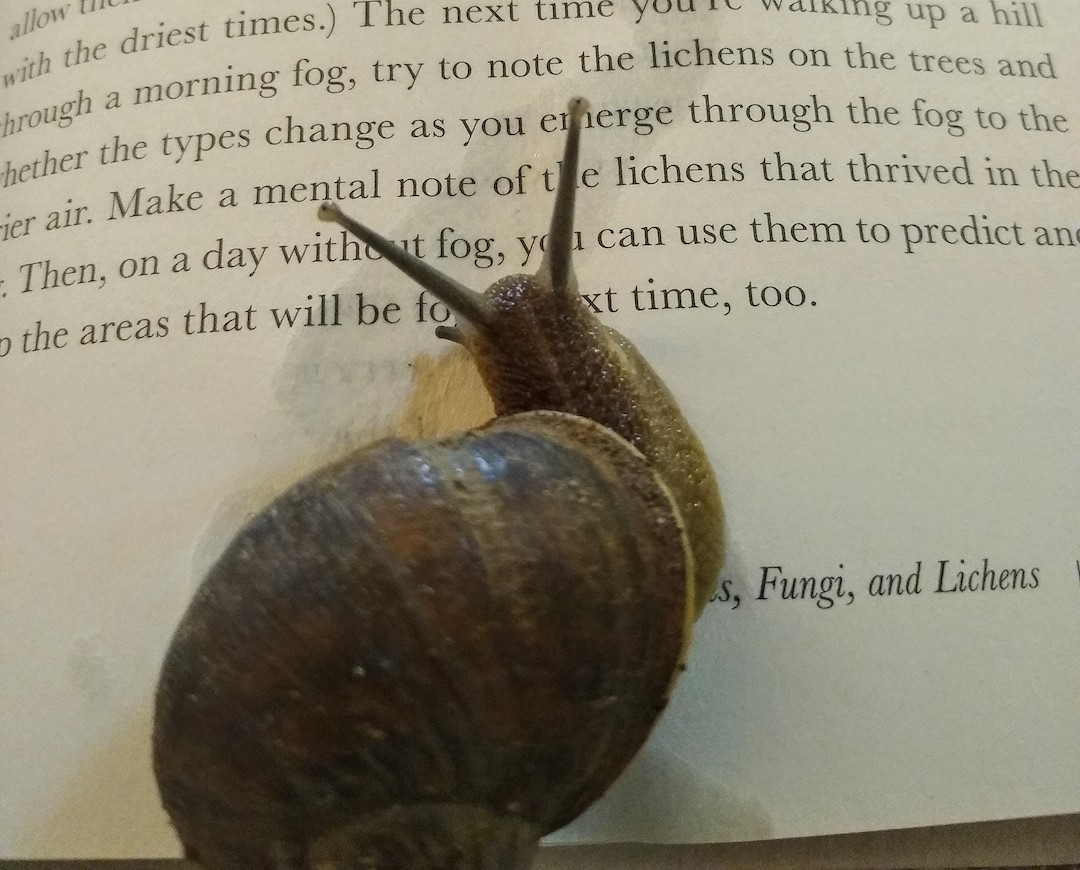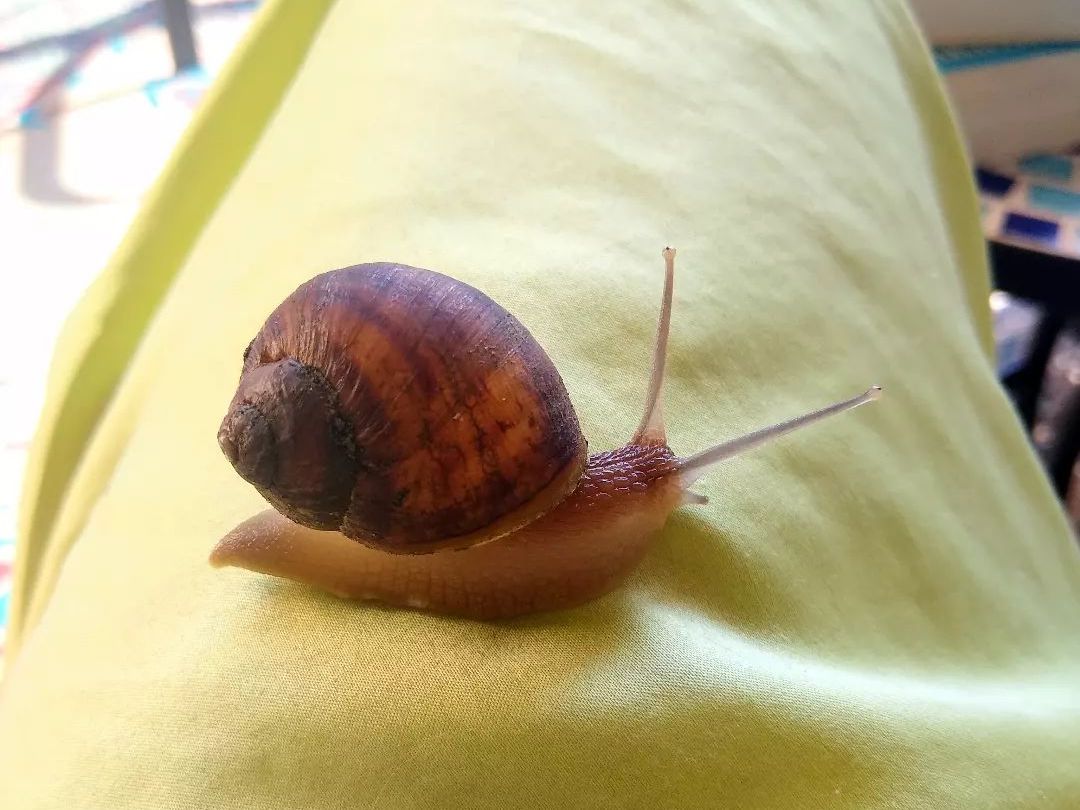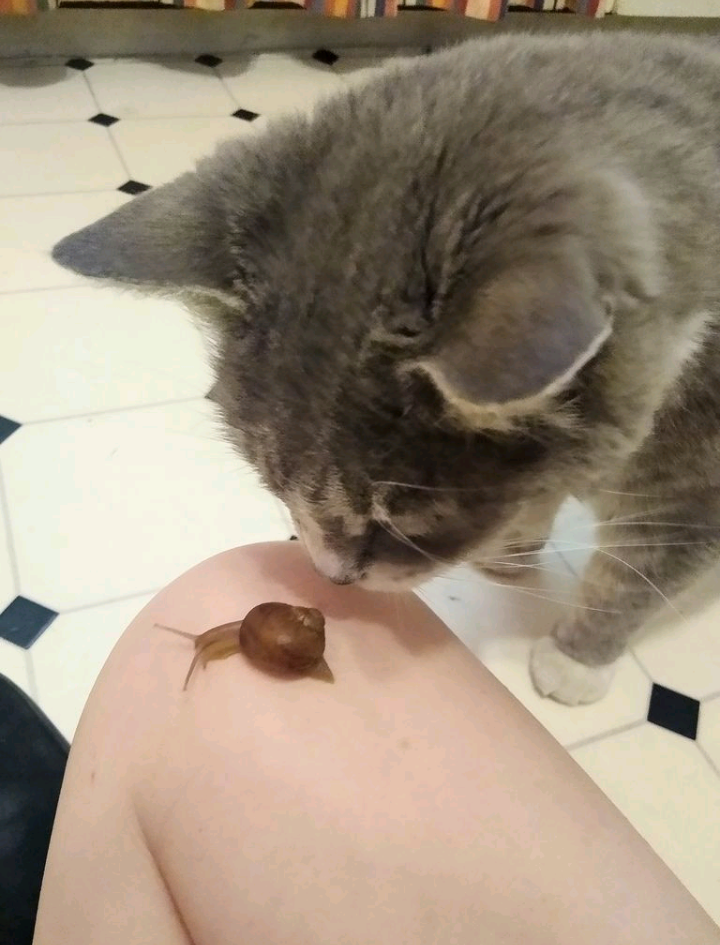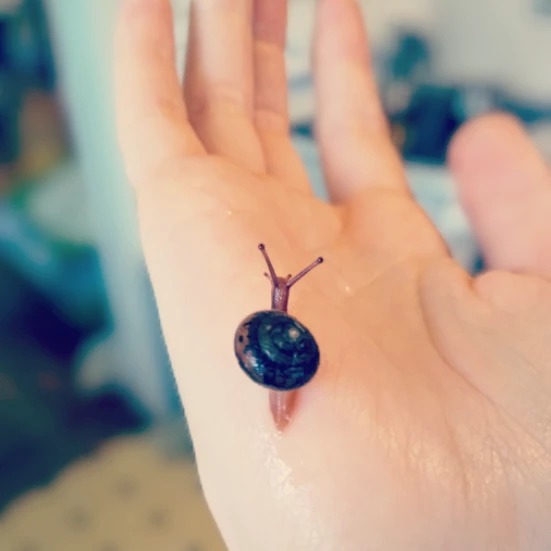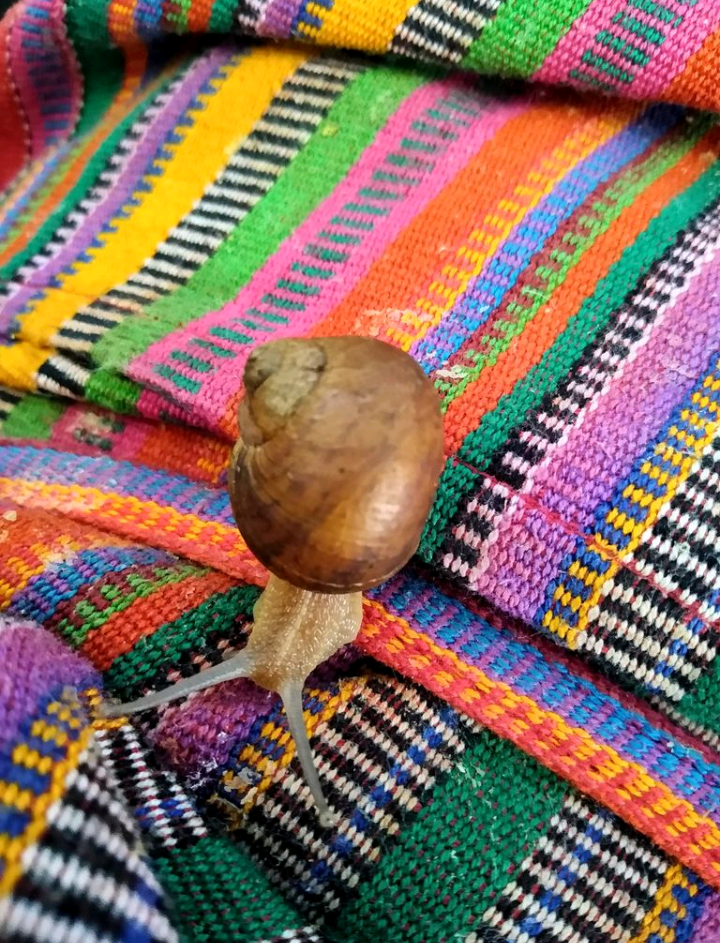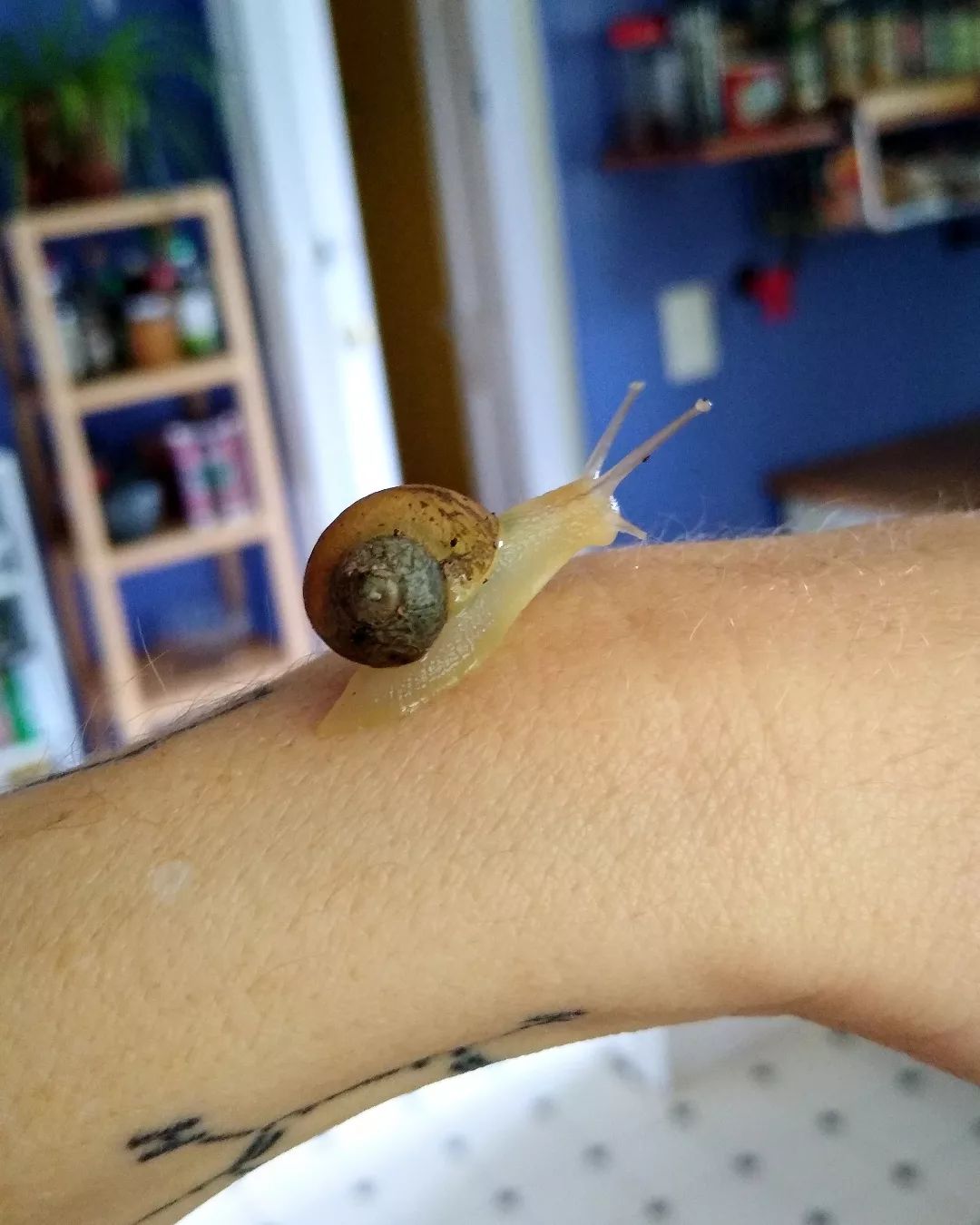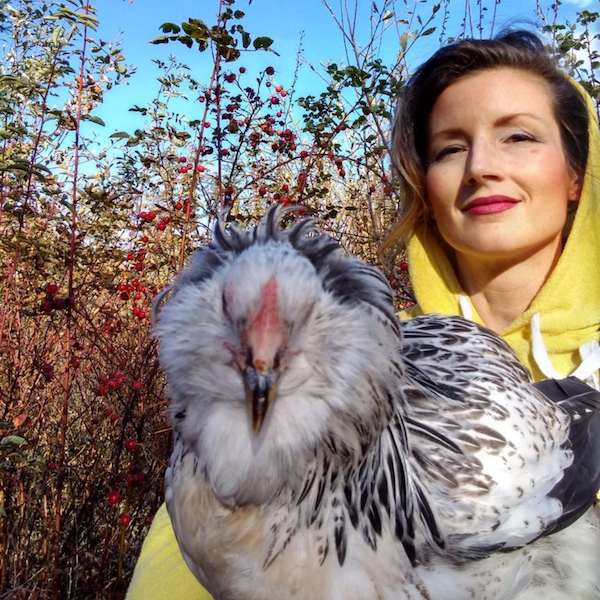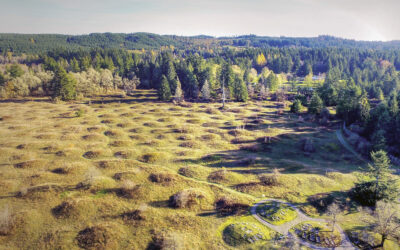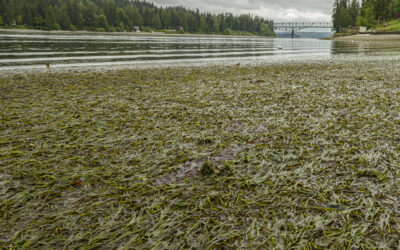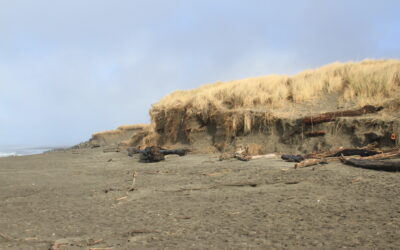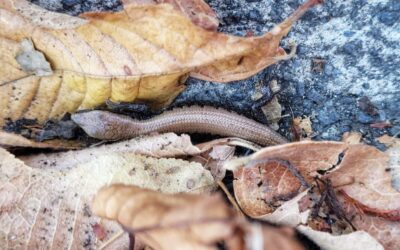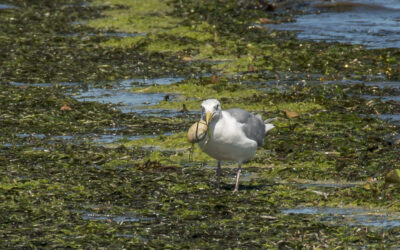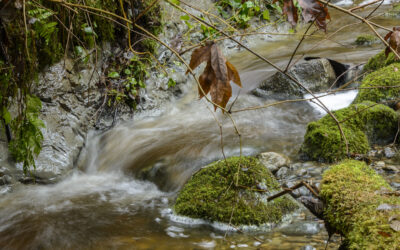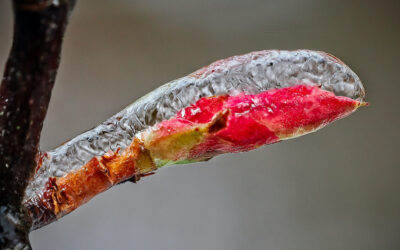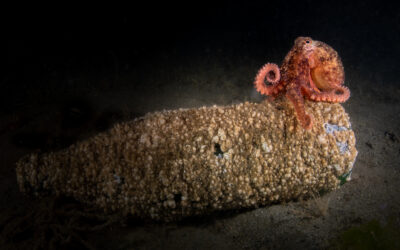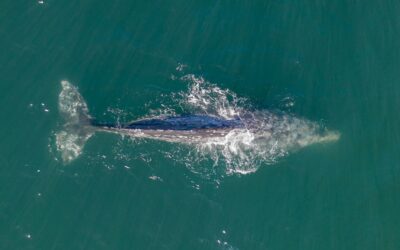LEARNING FROM A SNAIL'S PACE
by Michelle Ryder, Spring 2023
Photos by Michelle Ryder except as noted
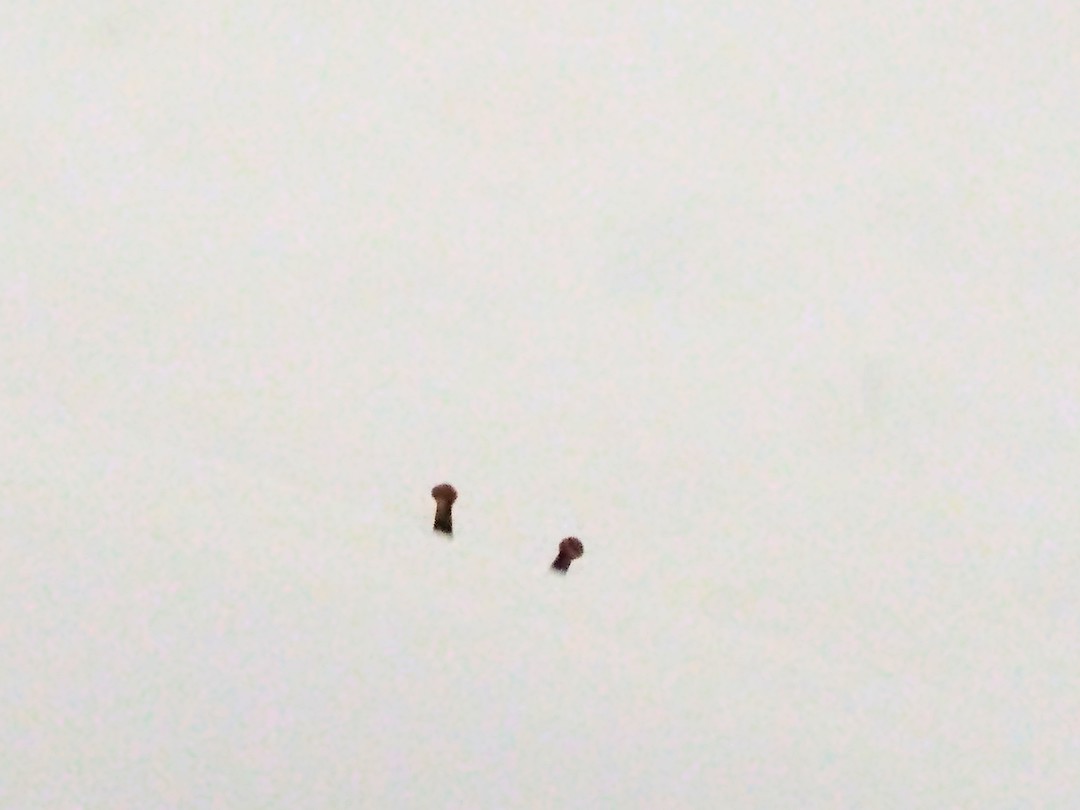
Mapfire peering over the side of the bathtub from inside of it.
LEARNING FROM A SNAIL'S PACE
by Michelle Ryder, Spring 2023
Photos by Michelle Ryder except as noted
In 2022 a snail came into my life. And stayed.
Late last winter, my mom, being a curious woman, brought a few snails inside to see what would happen. By furnishing them with a moist, temperate, and secure environment brimming with epicurean delights, she inadvertently created the perfect conditions for snail boinking.
Soon, my mom had 29 adoptable baby snails. I took one home and named it Mapfire.
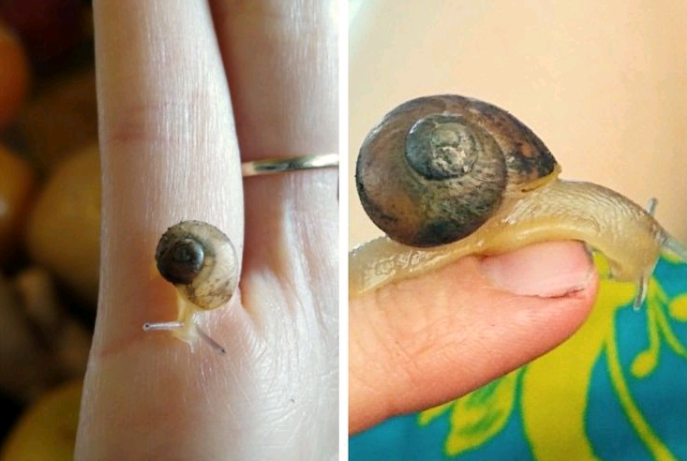
Baby vs. adult Mapfire.
I have had Mapfire for nearly a year. At first, she was half the size of my pinky nail and nearly translucent. Now, her shell is a dark brown and an inch across. I clean her tank weekly and change her food every few days; her favorite fare is crisp romaine lettuce.
Mapfire is a great source of amusement on a budget. As a gastropod (Latin for belly-footed), she races through the world on her stomach, averaging a pace of 1.3 centimeters (1/2 inch) per second — quick enough to teach me not to let my guard down. Once, while I was momentarily distracted, she escaped her tank and started eating my mail. After looking up what paper is made from, I wasn’t surprised she succumbed to the temptation of processed food. Paper is made of cellulose, which is a structural element in plants. My electric bill was snail pizza in her eyes.
Through observation and play, we have formed quite a human-snail bond, or at least I like to think so. She’s curious and often reaches for my fingers when I try to set her down. For playtime, I let her crawl on my arms or clothes and other safe surfaces, like old cups or the bathtub. Afterwards I wash everything she touches because snails can host parasites, including, in warmer climates, a nematode that can cause meningitis in humans.
I know Mapfire enjoys her time with me, based on her behavior. Snails will produce a protective foam when scared or annoyed, but, with me, Mapfire is all slime all the time. The slime trails she leaves on my arms are not, however, chemically identical. Snails produce different slime variations based on their needs. If she’s defying gravity she will produce stickier, thicker slime; if she wants to glide along, she’ll excrete slicker, more fluid slime. Some snails can produce a defensive toxic slime to coat exposed dorsal areas, like the upper body and head.
Snail slime isn’t any ordinary goo, but a liquid crystal. Liquid crystal is the fourth state of matter, partly a liquid and partly a solid. Essentially, it exhibits orderly patterns of organization on the molecular level, like a solid, but it flows like a liquid. Soapy water is an example.
There are two main categories of terrestrial (land) snails: native and non-native. The native snail you are most likely to see is the Pacific sideband snail (Monadenia fidelis). Part of its range is the Pacific Northwest — the Salish Sea — spanning from Budd Inlet in Olympia, Washington, up north to the Discovery Islands in British Columbia, Canada.
The Pacific sideband snail is beautiful; its shell is deep shades of chestnut with black or reddish banding. They eat fungi and vegetation, especially decaying matter. But what sets them apart from Mapfire, and most of the snails that we see, is their habitat. They stick to the forest. These are not the urban snails eating what’s in your flower beds and boxes. Those are non-native snails, like Mapfire.
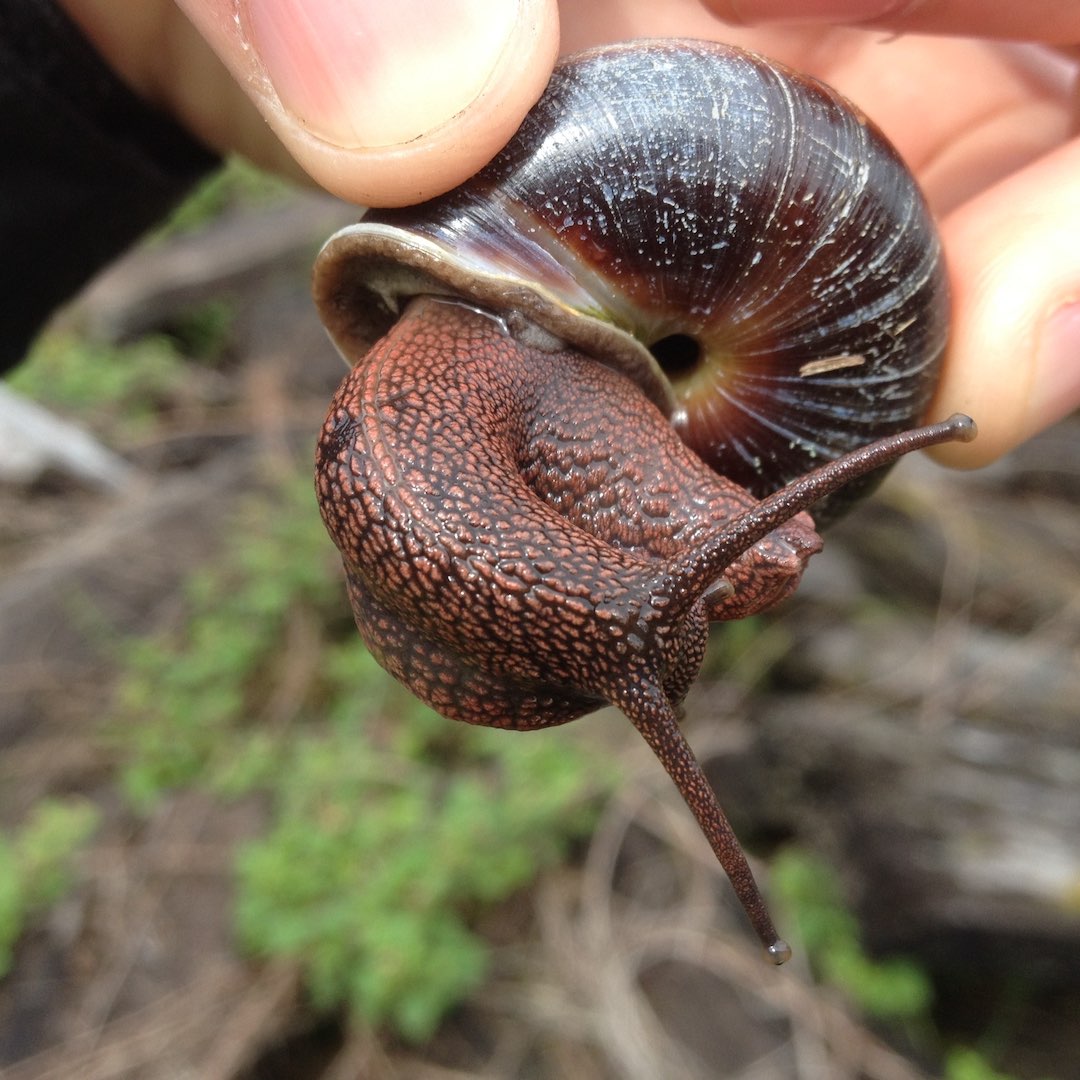
Native Pacific sideband snail. photo by Brandon Drucker
Mapfire is one of the two most common types of non-native snails, a common garden snail (Cornu aspersum), which are typically duller shades of brown with less defined banding. The other common species is the grove or lemon snail (Cepaea nemoralis), which are bright to faded shades of yellow and brown with deeply defined banding.
Mapfire, as you can see, is a rather unrelieved brown, but she is far from boring. Even though I have gendered her as female, she is, like all land snails, a hermaphrodite, housing both female and male reproductive organs. One of these organs is world famous, for it comes to us cloaked in the popular lore of cupid: the love dart.
The love dart is a tiny arrow that snails shoot into each other when mating. But gastropode aim is terrible! Sometimes the love dart can end up killing the receiving snail or lodging itself partially in the body. The point of the love dart, though, is to ensure that the pierced snail uses all the sperm from the sender, which is accomplished by special hormones in the mucus coating the love dart. Many scholars claim this eccentric mating ritual, which can be observed by the naked eye, is the origin of the ancient Roman god of love, Cupid — but surely dating singles can appreciate that “OkSnail” doesn’t have the same amorous ring as “OkCupid.”
The problem with non-native snails is us. These snails are synanthropic creatures, which means they thrive in environments created by humans, like gardens, flowerbeds, agricultural fields, abandoned overgrown lots, or any land disturbed by human activity. To quote a famous movie line, “If you build it, they will come.”
Non-native snails have a couple of habits that make them hard to eradicate: they are generalists, which means they nosh on a wide variety of foods; they can estivate (hibernate) when the surrounding environment becomes too hot, cold, or dry; and, they are nocturnal and like to wreak havoc while you sleep.
Combined, these factors mean that non-native snails can easily adapt to a variety of ecological niches. And, of course, the French immigrant who craved the flavors of home wasn’t considering this when he asked his family in France to send him some garden snails in the mail. While breeding them for food, a few escaped and quickly adapted to their new environment in California and beyond.
This is just one of the many ways non-native snails have been introduced to North America, a process that follows the human story of commerce and colonization (most non-natives come from Europe). Today, plant nurseries are a leading contributor to their spread; tiny eggs hitchhike a ride on the plants that go straight to your yard or garden. Snails also arrive on imported fruits and veggies.
In front of a mirror, if her vision were better (snail vision is poor), Mapfire would be able to observe her two eyes, retractable and embedded in her top tentacles, and below them, a set of sensory tentacles used for smelling, tasting, and touching. Her world is a quiet one; gastropods have no sense of hearing.
This means she doesn’t hear me when I blandish her with compliments, telling her how cute she is. She’s got wonderfully moist, soft skin thanks to her slime. Repulsive or not, this slime is currently the face of some of the trendiest beautification products promising to banish wrinkles, heal acne scars, and shrink pores. For $375 you can enjoy a slightly painful microneedling treatment where snail mucus is pushed deep into the skin. This treatment is called EscarGlow, not to be confused with escargot, cooked snails.
In their native habitats, snails are vital players. They are scavengers and decomposers. By helping to break down dead plant matter, and in some cases animal matter, they are recycling energy and nutrients back into the soil with their nutrient-rich feces. Along with countless other critters, like microbes and insects, they are nature’s cleanup crew. In the food web, they are at the bottom, and provide an important source of food for many birds and small mammals.
Mapfire is one of those frivolous but necessary things in my life. She has taught me to slow down, to observe, to appreciate. She makes me a better naturalist and a better human. She is an unloved being in this world, a member of the unloved animal club along with mice and spiders. Because of her, I think more about the lives of the unloved, deepening my understanding of life.
Sure, it doesn’t feel like any big accomplishment watching her summit the tip of my finger, but it’s one of those little details that makes a life — my life. Mapfire is a gentle reminder of how I want to be in this world, how I want to move — at my own pace — which lies somewhere between human and gastropod.
While the Pacific sideband, garden, and groves snails can be easily spotted around the Salish Sea, in reality there’s an unidentified number of snails in the region. Snails are incredibly understudied.
“Until we have good genetics work, for example,” says Clarissa Dirks, a molecular biologist at The Evergreen State College, “we can’t easily identify them, so we won’t even know when we have new species around you.” Dirks has studied snails under top malacology (study of mollusks) researchers at the University of Hawaii and has taken her students into the field in Olympia to conduct snails surveys, turning up “examples of what may be previously unknown species.”
So don’t be surprised if one day you come across a strange looking snail. Possibly a new species, local malacologists will be waiting for your call!
FIND OUT MORE
How One Italian Company Milks Slime Out Of Thousands Of Snails. Business Insider, Aug 14, 2022.
The Love Dart. The Living World of Mollusks.
SLIME Pacific Northwest. iNaturalist and Burke Museum.
Malacology (SNAILS & SLUGS) with Jann Vendetti.” Alie Ward, Ologies Podcast. June 16, 2018.
The slowest invasion: Non-native snails take over Northwest. Chris Winters, The Herald. June 25, 2016.
Table of Contents, Issue #19, Spring 2023
Underground Movement
by Amy Porter, Spring 2023 Wolf Haven mounded prairie. photo by Wolf Haven Internationalby Amy Porter, Spring 2023On Wolf Haven’s mounded prairie, there is an underground movement happening that largely goes unnoticed — bioturbation (the movement of soil) by Mazama...
A Window on Eelgrass
by Kylie Rench, Spring 2023 photos by John F. Williams by Kylie Rench, Spring 2023 photos by John F. WilliamsLow tide opens a window for the beach walker onto the vibrant world of eelgrass meadows. Submerged by salt water during most tidal cycles, these meadows are...
Poetry-19
Spring 2023 photo by Thomas NolandSpring 2023Sand and Water by Jeffrey Hummel Sand infinite amountsappearing all the sameBlowing, shifting, changingAbrasiveA handful you can’t holdSlides through your fingersGets into everythingevery part of youEvery nook, crack...
Lizard’s Locomotion
by Karin Kersteter, Spring 2023 illustrations by Karin Kersteter by Karin Kersteter, Spring 2023illustrations by Karin KersteterThere is an expression “leave the leaves,” which is designed to encourage people to let leaves lie in yards and gardens, rather than rake...
Turbulence
by Rebekah Boettcher, Spring 2023 photos by Rebekah Boettcher except as noted Seagull with clam. photo by John F. Williamsby Rebekah Boettcher, Spring 2023 photos by Rebekah Boettcher except as notedHow did I get here? I ponder, stunned once again as we walk down to...
Movement Imagery
Spring 2023 Cowling Creek, Suquamish. photo by John F. WilliamsSpring 2023Here is a collection of photos and art work depicting various kinds of movement. You may enjoy playing the audio file below as you view the photos. The music evokes the feeling of motion through...
Plant motion
text and photos by John Bolivar, Spring 2023 Ribes sanguineum floral bud encased in ice.text and photos by John Bolivar, Spring 2023At first look it would appear that plants do not have the luxury of movement to help them avoid bad weather — like our recent bout of...
2022 Photo Challenge
by MaST Center Aquarium, Spring 2023 Jurors' Favorite - On the Bottle, Veronika Nagy. Small octopus sitting on a bottle. by MaST Center Aquarium, Spring 2023The Underwater Photography Challenge focuses on bringing divers to Redondo Beach, Washington, to highlight the...
Gray Whales
by Laura Marx, Spring 2023 Gray whale off the Oregon coast. photo by Dan Meyers on Unsplash by Laura Marx, Spring 2023Gray whales and their amazing migrations up and down the west coast of the U.S. have made an impact in my life ever since I was a child. In the 1990’s...
PLEASE HELP SUPPORT
SALISH MAGAZINE
DONATE
Salish Magazine contains no advertising and is free. Your donation is one big way you can help us inspire people with stories about things that they can see outdoors in our Salish Sea region.
We also don't advertise Salish Magazine, so please spread the word of this online resource to your friends and colleagues.
Thanks so much for your interest and your support.
We also don't advertise Salish Magazine, so please spread the word of this online resource to your friends and colleagues.
Thanks so much for your interest and your support.

